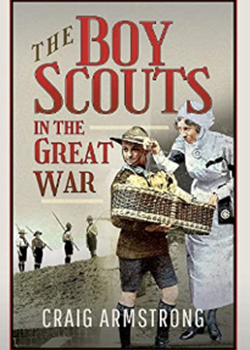The Boy Scouts in the Great War by Craig Armstrong
- Home
- World War I Book Reviews
- The Boy Scouts in the Great War by Craig Armstrong

(Pen & Sword, 2021) £19.99, hardback, 208 pages, 100 b/w illustrations ISBN: 978–1–52672–324–6
There’s plenty of fascinating information crammed into Craig Armstrong’s account of the Scouts’ experience of the First World War. The stories range from those of diligent service to outright heroism, culminating in the courage and sacrifice of that most famous ex–Scout of all, Boy 1st Class John Travers Cornwell who earned his Victoria Cross on the deck of HMS Cheshire in 1916. Cornwell’s bravery was a model for the Scouts at home and his life was memorialised in the association’s Cornwell Badge which was awarded for behaviour that echoed his valour. Of course, such opportunities did not fall into the path the majority and most of the war service performed by Scouts involved helping with the harvest or organising bottle collections to raise funds for the canteens set up to support soldiers on the Western Front. Armstrong demonstrates the value of the Scouts to the nation, the way in which they were able to assume roles that would otherwise have been hard to fill – men could not be spared to watch the coastline or run messages, activities that the boys undertook with diligence and enthusiasm. Some of the new skills that the Scouts learned provide a glimpse into the strange world of the war, and there are terrific images of patrols doing exciting things like building bridges from wooden staves, indeed, the extensive use of images is a real strength of the book.
However absorbing the details of the primary research material, readers interested in the history of the war will be looking for a clearer context, an argument, something that links the individual fragments together into a focused narrative, and that is lacking. The book is an assemblage of descriptive facts with a chronological structure that doesn’t facilitate an exploration of the broader themes that might be associated with a study of the Scouts. For example, Peter Grant’s Philanthropy and Voluntary Action in the First World War might have been used to provide a deeper appraisal of the Scouts’ work as fundraisers. Rosie Kennedy’s chapter on ‘Children in Uniform’ in her book The Children’s War would have helped the author provide a stronger context for the general discussion. A significant part of the text is devoted to recounting the military careers and deaths of ex–Scouts, but there’s almost no linkage between those battlefield stories and the men’s actual scouting experience so the information feels disconnected and its relationship to a study of the organisation’s role in the conflict is tangential. The referencing is erratic in that the sources of some information are recorded, but a great deal is unattributed which makes its usefulness for other historians decidedly problematic.
Overall, this reads more as the recounting of a collection of historical fragments rather than a coherent and efficiently structured narrative that could have told us much more about the impact of the war on both the Scouts as an organisation and on its members.
Review by Rachel Duffett
(This review first appeared in the April 2022 edition of Stand To! (No.126) The journal of The Western Front Association which is published four times a year and is sent to members in print and digital forms.)





